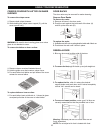
STORING FROZEN FOOD
NOTE: For further information about preparing food for
freezing or food storage times, check a freezer guide or a
reliable cookbook.
Packaging
Successful freezing depends on correct packaging. When
you close and seal the package, it must not allow air or
moisture in or out. If you do, you could have food odor
and taste transfer throughout the refrigerator and also dry
out frozen food.
Packaging recommendations:
Rigid plastic containers with tight-fitting lids
Straight-sided canning/freezing jars
Heavy-duty aluminum foil
Plastic-coated paper
Non-permeable plastic wraps
Specified freezer-grade self-sealing plastic bags
Follow package or container instructions for proper
freezing methods.
Do not use:
Bread wrappers
Non-polyethylene plastic containers
Containers without tight lids
Wax paper or wax-coated freezer wrap
Thin, semi-permeable wrap
Freezing
Your freezer will not quick-freeze any large quantity of
food. Do not put more unfrozen food into the freezer than
will freeze within 24 hours (no more than 2 to 3 lbs of food
per cubic foot of freezer space). Leave enough space in
the freezer for air to circulate around packages. Be careful
to leave enough room at the front so the door can close
tightly.
Storage times will vary according to the quality and type
of food, the type of packaging or wrap used (airtight and
moisture-proof) and the storage temperature. Ice crystals
inside a sealed package are normal. This simply means
that moisture in the food and air inside the package have
condensed, creating ice crystals.
NOTE: Allow hot foods to cool at room temperature for
30 minutes, then package and freeze. Cooling hot foods
before freezing saves energy.
NOTE: Do not store food near the sensor; it may cause
the sensor to malfunction.
USING YOUR REFRIGERATOR
14
WARNING
Suffocation Hazard
When using dry ice, provide adequate ventilation.
Dry ice is frozen carbon dioxide (CO )
2
. When it
vaporizes, it can displace oxygen, causing dizziness,
light-headedness, unconsciousness and death by
suffocation. Open a window and do not breathe
the vapors.
REFRIGERATOR SHELVES
The shelves in your refrigerator are adjustable to meet
your individual storage needs. These units are all glass
shelves.
Storing similar food items together in your refrigerator and
adjusting the shelves to fit different heights of items will
make finding the exact item you want easier; it will also
reduce the amount of time the refrigerator door is open,
saving energy.
IMPORTANT: Do not clean glass shelves with warm
water when they are cold. Shelves may break if exposed
to sudden temperature changes or impact, such as
bumping. For your protection, glass shelves are made
with tempered glass, which will shatter into small pebble-
sized pieces.
NOTE: Glass shelves are heavy. Use special care when
removing them to avoid dropping them.
Adjusting Shelves
Remove shelves from the shipping position and replace
shelves in the position you want.
To remove a shelf
:
Tilt up the front of the shelf in the
direction of (1) and lift it in the direction of (2). Pull the
shelf out.
To replace a shelf : Tilt the front of the shelf up and
guide the shelf hooks into the slots at a desired height.
Then lower the front of the shelf so that the hooks drop
into the slots.
NOTE: Make sure that shelves are leveled from one side to
the other. Failure to do so may result in the shelf falling or
spilling food.


















